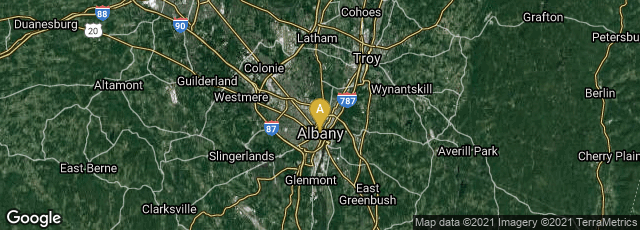

A: Albany, New York, United States
In 1850 printer, publisher and writer Joel Munsell of Albany, New York, issued a very ordinary looking octavo volume of 268 pages containing about 90 mostly brief sections entitled The Typographical Miscellany. Supposedly Munsell only printed 200 copies of this book, recognizing that it would mainly interest other enthusiasts for printing history --a small number of people at the time. In his Miscellany Munsell compiled a wealth of historical data in an ususually large number of short sections on a very wide range of subjects mostly to do with the history of printing, but also including comments on developments that were current when he wrote the book, presumably compiling the data as he enountered it, and issuing it as a book when he decided he had compiled enough. As the writer and printer and publisher, he was able to issue the book exactly as he saw fit. Munsell also seems to have printed the book on whatever paper he had at hand since some gatherings were printed on better paper than others, causing certain gatherings in the original edition to fox while other gatherings next to them are free of foxing.
The longest section by far in Munsell's Miscellany was Reminiscences of Printers and Printing in America, which occupied pp. 94-145, and recorded events between 1762 and 1820. Why he started as late as 1762 and cut off his record at 1820, thirty years before he published the book, he did not explain. He introduced this centerpiece to the volume this way:
"The following article, it will be seen at a glance, is far from being a complete chronology of American printing. On the contrary it consists of a few events, gathered from the four winds, and not before embodied in any single work. The period embraced is mostly within the memory of some of the fathers of the profession still among us, and some of the events are not elsewhere on record."
In addition to running his successful printing business, Munsell was a notable historian of the Albany region, writing and publishing between 1850 and 1859 a ten-volume Annals of Albany. Besides that huge work, Munsell compiled and published in 1858 through D. Appleton in New York a 546-page densely typeset reference book entitled The every day book of history and chronology: Embracing the anniversaries of memorable persons and events, in every period and state of the world, from the creation to the present time. The arrangement of this work was unlike most other timelines in that Munsell organized it so that users could look up in it what had happened on each day of the year going back to the beginning of records. Notably Munsell included little information on the history of printing in this volume. This was an expansion of a work that Munsell originally compiled and published in 1841. Munsell did not identify himself as the printer of the 1858 edition, and the printer of the book was not identified, so it is probably that he left the production to D. Appleton.On top of that in 1857 Munsell published the first edition of his A Chronology of Paper and Paper-Making. This he printed and published himself; he also had copies sold by Trubner & Co. in London.
Because of my long-standing interest in the development of the mechanization of printing and book production "Statistics of Printing Offices in Albany" that Munsell published on pp. 252-56 caught my attention. Statistics like these I have not seen compiled for any other city in the 19th century. That Albany, a city of about 35,000 people at the time, was the state capital of New York would have enabled it to support a larger number of printers than might have been found in a typical American city in order to print newspapers reporting on the activities of the state government. Albany was also a major producer of books in the 19th century, second to Boston in this regard, and producing more than in New York City.
What will be evident from Munsell's data is that most of the printers in Albany, including Munsell himself, had mechanized their production extensively, with printing machines powered by steam engines, in the 29 years since Daniel Treadwell had invented the first American power press, and in the 20 years since Isaac Adams had invented the Adams Power Press. Notably, however, none of the Albany printers had introduced the latest and most expensive high-speed rotary presses designed and produced by Hoe & Co., presumably since the volume of printing needed in Albany did not require such high speed. Munsell was clearly impressed with Hoe's new presses as he devoted a section or chapter to Hoe's Fast Printing Machine and reproduced one of the standard wood engravings of the machine as one of the few illustrations in his book.
Here is what Munsell reported on Statistics of Printing Offices in Albany:
"Every establishment within the city of Albany, claiming to be a printing office, is here enumerated, with the number of persons employed, which embraces not only journeymen and apprentices, but girls and others engaged about the business. The occupation to which the proprietor was bred is also named.
"CHARLES VAN BENTHUYTSEN, Practical Printer.
Book and Job Office, No. 407 Broadway; office established by Van Benthuysen & Wood in 1807. Printer for the state.
Steam engine, 30 horse power
3 Napier presses
4 Adams power presses.
2 Tufts power presses.
1 Ruggles engine. [A foot-powered platen press capable of about 1500-2000 impressions per hour.]
6 hand presses.
Employs 120 to 140 persons.
Has a Book Bindery, Type and Stereotype Foundery, Machine Shop, and Paper Mill conneced with his business.
LUTHER TUCKER, Practical Printer.
Proprietor of The Cultivator, monthly; printed by C. Van Benthuysen.
JOEL MUNSELL, Practical Printer.
Newspaper, Book and Job Office,Nos. 58 and 37 State street; office established by Hosford & Wait in 1831. Prints Albany Daily State Register, and semi-weekly and weekly, for Fuller & Seward, proprietors.
Steam Engine
1 Napier Press
2 Adams power presses
1 Ruggles engine
4 hand presses
1 card press.
Employs from 40 to 60 persons.
Has a Type and Stereotype Foundery, and small Bindery.
FULLER & SEWARD.
Proprietors Albany Daily State Register, No. 37 State street; established 1850. Firm consists of Jerome Fuller, and Alexander Seward, attorneys, and editors. Cyril V. Gray, reporter.
Paper printed by Joel Munsell.
TEN EYCK & CO.
Newspaper, Book and Job Office, No. 67 State street; office established by Webster & Wood in 1825. Firm consists of Thurlow Weed and George Dawson, practical printers and editors, and Visscher Ten Eyck, financial partner. Print Albany Evening Journal, and semi-weekly and weekly. John Ten Eyck, commercial editor.
Steam engine.
1 Napier press.
WEED, PARSON & CO. Book and Job Office connected with the above. Firm consists of Ten Eyck & Co., and James B. Weed and John D. Parsons, Practical Printers.
1 Adams power press
2 Ruggles engines.
3 hand presses
Employs about 40 persons in both departments.
Have a Book Bindery
H. H. VAN DYCK, Practical Printer and Editor.
Newspaper, Book and Job office, corner Broadway and Beaver street; established in 1840 by Vance & Wendell. Prints Albany Evening Atlas, and weekly.
James Cassidy, attorney, principal editor, John Sharts, printer, asistant editor.
Steam engine
1 Austin power press
1 Napier
2 hand presses
1 Ruggles engine
Employs 27 persons
HENRY D. STONE, Practical Printer.
Newspaper and Job Office, corner State and Green streets; established 1820. Prints Albany Morning Express, daily, for Stone & Henly.
1 Napier
1 Ruggles engine
2 hand presses
Employs 10 persons
STONE & HENLEY.
Proprietors of Albany Morning Express. Firm consists of Alfred Stone, business partner, and Edward Henly, printer.
Jacob Cuyler, attorney and editor.
Paper printed by Henry D. Stone.
CROSWELL & SHAW.
Newspaper Office in Exchange Building. Establishedi n 1813 by Jesse Buel. Firm consists of Edwin Croswell, practical Printer, Sherman Creswell, attorney, and Samuel M. Shaw, Practical Printer. Print Daily Albany Argus, and Weekly and semi-weekly. Wm. Lacy commercial editor.
1 Napier press.
Employs about 21 persons.
H. J. HASTINGS, EDITOR.
Newspaper and Job office, No. 72 State street, established in 1843. Prints Albany Daily Knickerbocker.
2 Napier presses.
3 hand presses
Employs 26 persons.
GRIFFIN & FARNSWORTH.
Print the Albany Dutchman weekly in the same establishment. The firm consists of Rich. M. Griffin, grocer, and Addison Farnsworth, printer.
JASPER HAZEN & Son.
Newspaper and Job Office, No. 368 Broadway, established in 1844. Print Christian Palladium, semi-monthly, Christian Herald and Messenger weekly, Temperance Courier, and Washingtonian and Recabite.
Jasper Hazen, preacher and editor, and Jacob T. Hazen, editor.
Steam engine.
1 Napier
A. B. CASE, practical printer, has a job office connected with the above.
2 hand presses
1 card press
Employs 10 pesons in both departments.
BENJ. F. ROMAINE.
Newspaper and Job Office, No. 334 Broadway; established 1846. Prints American Spectator, weekly, and Half-Dollar Monthly. R. R. Romain preacher and editor.
Steam engine
1 Napier
2 hand presees
1 card press.
Employs 5 persons.
JOHN NEW, Practical Printer.
Newspaper and Job Office, No. 29 Beaver street. Prints the Albany Switch, weekly.
1 Ruggles einge
1 hand press.
Employs 4 persons.
FRINE & GRANT
Newspaper and Job Office, corner of Washing and Hawk streets; established 1845. Print Albany Freeholder, weekly. Firm consists of M. Frank, editor, Philand S. Grant, printer
1 hand press.
Employs 3 persons.
BAKER TAYLOR, carriage-maker.
Job Office, No. 7 North Pearl Street.
1 Ruggles engine.
2 hand presses.
Employs 2 workmen.
R. ANDREWS, painter
Paper and Job Office, No. 183 Third street, Arbor Hill, established 1848. Prints Busy Bee, weekly.
1 Ruthven press
Employs 1 person."